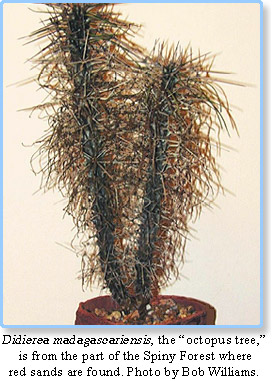Didiereaceae (2019)
 By Bob Williams (March 2019)
By Bob Williams (March 2019)
Madagascar separated from Africa millions of years ago. During this time, the plants and animals adapted to the new conditions. There was no human activity on the island until 1200 B.C. This allowed the flora and fauna to evolve in isolation. Over 90 percent of Madagascar’s plants and animals are found only on the island. This distinctive ecology has led some to refer to Madagascar as the “eighth continent,” and the island has been classified by Conservation International as a biodiversity hotspot.
The majority of the island gets plenty of rain via the trade winds from the Indian Ocean. The rainy season lasts from November through April. The eastern part of the island is tropical with a central highland that is cooler, but still wet. This geographical highlight is of the most interest to us in the weird succulent world.
This highland area can reach an elevation of over 4,000 feet. Its geology creates a “rain shadow” in the southern and southwest sections of the island. This nearly 17,000-square-mile area, commonly referred to as the “Spiny Forest,” is on many of our “bucket lists.”
In order to understand the plants that grow in this region, we need to understand the geology and the ecosystem. Even though it is dry, this region can get 12 to 20 inches of rain during the rainy season. This sounds pretty good when you compare it to rainfall levels in Namibia and the southwestern regions of southern Africa. However, this area of Madagascar can be subject to periods of prolonged drought that last years.
The geology is also a factor. There are two major rock types in this region. In the south and southeast areas, red sand is the predominate soil. In the higher elevations in the southwest, a fast-draining limestone is found. There is little organic material to hold moisture. When rains do occur, the water drains quickly. The highly porous nature of the soil and bedrock provides little opportunity for vegetation to absorb moisture.
In order to survive, plants here have large tap roots that seek out ground water. The plants are woody, and when the rains do come, their trunks swell. The plants have a single goal: Store water and don’t lose it. Some of the more majestic plants found in this area are baobab trees.
This brings us to the family Didiereaceae. This is a small family of just four genera and 11 species of flowering plants. The genera are Alluaudia, Alluaudiopsis, Decaryia and Didierea. The most significant fact is that these plants are only found in the Spiny Forest and nowhere else in the world outside collections.
Didiereaceae plants closely resemble some forms of cacti, but are not related. Unlike cacti, Didiereaceae species produce small, deciduous leaves, which are protected by mean-looking thorns and spines that grow directly out of the plants’ many branches. The leaves can have a waxy covering that helps prevent water loss. During the dry season, these leaves dry up and fall off.
These are not small plants that live low to the ground. They can grow to heights of 20 feet or more. Growth can be relatively rapid when rains occur. Some people let them grow with a wild look, while many train them as bonsai plants.
The plant I have in my collection is Didierea madagascariensis. It is nicknamed the “octopus tree” due to the long, thin leaves that completely cover the spines of the plant. These plants are from the part of the Spiny Forest where the red sands are found. My plant is still young, only 10 inches tall. In the wild, this plant can be found in the 12- to 20-foot range.
During the growing season, D. madagascariensis can be watered regularly with a good soaking. Allow the soil to dry before another watering. In the fall, watering should be cut way back. I have found some sites that say not to water at all during the dormant period.
It goes without saying that a fast-draining mix is preferred. Mine is in the same mix I use for most of my plants, but you may be able to use a coarse sand mix for this plant.
D. madagascariensis can be propagated by cuttings. These plants are not rare and can be found online and at our show and sale.
Sources:
World Wildlife Fund – https://www.worldwildlife.org/ecoregions/at1311
Wikipedia – https://en.wikipedia.org/wiki/Madagascar_spiny_forests, https://en.wikipedia.org/wiki/Madagascar
Llifle Encyclopedia of Succulents – http://www.llifle.com/Encyclopedia/SUCCULENTS/Family/Didiereaceae/11208/Didierea_madagascariensis
